
Skippers are a group of butterflies placed in the family Hesperiidae within the order Lepidoptera. They were previously placed in a separate superfamily, Hesperioidea; however, the most recent taxonomy places the family in the superfamily Papilionoidea, the butterflies. They are named for their quick, darting flight habits. Most have their antenna tips modified into narrow, hook-like projections. Moreover, skippers mostly have an absence of wing-coupling structure available in most moths. More than 3500 species of skippers are recognized, and they occur worldwide, but with the greatest diversity in the Neotropical regions of Central and South America.

Hesperia comma, the silver-spotted skipper or common branded skipper, is a butterfly of the family Hesperiidae. It is known as silver-spotted skipper in Europe and common branded skipper in North America where the butterfly Epargyreus clarus, a spread-winged skipper, also has the common name of "silver-spotted skipper".

The large chequered skipper is a species of butterfly in the family Hesperiidae. It is the single member of the monotypic genus Heteropterus. The species can be found in isolated populations in Europe and east across the Palearctic to Central Asia and Korea. It is endangered in the Netherlands.

Grass skippers or banded skippers are butterflies of the subfamily Hesperiinae, part of the skipper family, Hesperiidae. The subfamily was established by Pierre André Latreille in 1809.
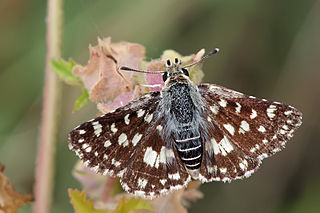
Pyrginae, commonly known as spread-winged skippers, are a subfamily of the skipper butterfly family (Hesperiidae). The subfamily was established by Hermann Burmeister in 1878. Their delimitation and internal systematics has changed considerably in recent years with the most recent review being in 2019.

Hesperia, the branded skippers, is a Holarctic genus in the skippers (Hesperiidae) butterfly family. Most species are endemic to North America, Hesperia comma is widespread throughout the region. H. florinda is endemic to temperate eastern Asia. H. nabokovi is endemic to Hispaniola.

Pyrgus is a genus in the skippers butterfly family, Hesperiidae, known as the grizzled skippers. The name "checkered" or "chequered skipper" may also be applied to some species, but also refers to species in the genera Burnsius and Carterocephalus. They occur in the Holarctic with an additional group of species extending to the Neotropic.

The carline skipper is a butterfly and a species of the skipper. It is a montane butterfly only found in southwestern areas of the Alps. It can be an abundant species within this restricted range.
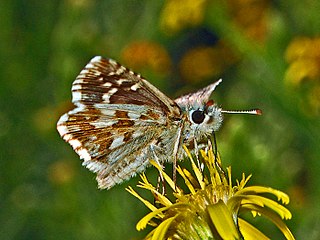
The rosy grizzled skipper is a species of skipper.

Hedylidae, the "American moth-butterflies", is a family of insects in the order Lepidoptera, representing the superfamily Hedyloidea. They have traditionally been viewed as an extant sister group of the butterfly superfamily Papilionoidea, but a 2014 phylogenetic analyses has suggested Hedylidae is a subgroup of Papilionoidea, and not a sister group, and are more accurately referred to as butterflies rather than moths. They are represented by a single Neotropical genus Macrosoma with 35 currently recognized species.
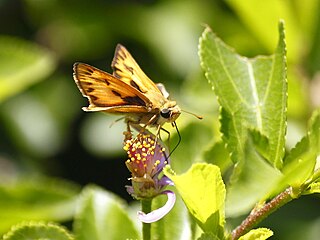
The fiery skipper is a species of butterfly in the family Hesperiidae. Reaching approximately 1 inch (2.5 cm) in length, male fiery skippers are orange or yellow while the females are dark brown. Small brown spots may be observed on both the hindwing and forewing of both sexes although to a varying degree. Females may be darker brown overall with pale checkered markings on the hindwing. Fiery skipper larvae, or caterpillars, are greenish pink-grey with a black head and constricted neck. These larvae are often considered pests and can feed on Bermudagrass, creeping bentgrass, and St. Augustine grass.
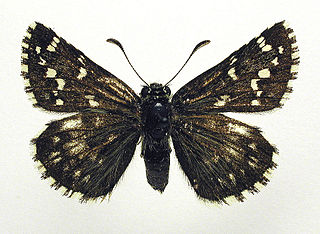
The northern grizzled skipper is a Holarctic species of skipper butterfly with a range in North America from the subarctic to the north, New Mexico to the south, and the Appalachian Mountains to the east.In the Palearctic the species which was described from Norway is distributed across Scandinavia and the northern part of European Russia across the Urals through northern Asia to the Altai.

Erynnis persius, commonly known as Persius duskywing, is a species of butterfly in the family Hesperiidae that occurs in North America. It is a threatened species in Michigan and is protected by law. The subspecies Erynnis persius persius is listed as endangered in the Connecticut by state authorities.

Heliopetes is a Neotropical genus of spread-winged skipper butterflies in the family Hesperiidae.

Calpodes ethlius, the Brazilian skipper, larger canna leafroller or canna skipper, is a butterfly of the family Hesperiidae. It is found in the United States from southern Florida and southern Texas, south through the West Indies, Mexico, and Central America to Argentina. Strays and temporary colonies can be found north to southern Nevada, northern Texas, Illinois and Massachusetts.

Polites mardon, the Mardon skipper, is a butterfly native to the United States northwest coast.

Euphyes bimacula, the two-spotted skipper, is a butterfly of the family Hesperiidae. It is found in North America, from northeast Colorado and western Nebraska; eastern Nebraska east to southern Quebec; southern Maine south to central Virginia; coastal plain south to Georgia; and the Gulf Coast.
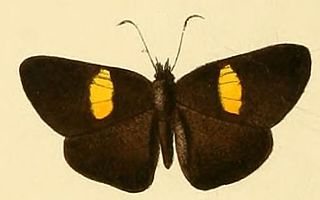
Potamanaxas flavofasciata, the yellowbanded skipper, is a butterfly in the family Hesperiidae. It is found in Ecuador, Peru and Bolivia.

Carterocephalus palaemon, the chequered skipper or arctic skipper, not to be confused with the large chequered skipper, is a species of woodland butterfly in the family Hesperiidae. This butterfly can live in grasslands. The upperside of the butterfly is brown with orange spots and on its underside the chequered skipper is orange with brown spots. Chequered skippers are found in Great Britain and other European regions, but seen locally in Japan and in North America. The size of the chequered skipper ranges from 19 to 32 mm with females being larger. In the 1970s, the chequered skipper went extinct in England due to the new management of the woodlands.


















